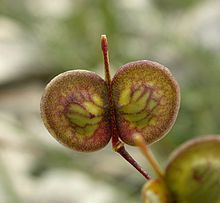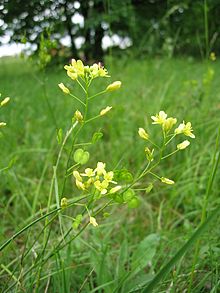Smooth-eyed pods
| Smooth-eyed pods | ||||||||||||
|---|---|---|---|---|---|---|---|---|---|---|---|---|

Smooth-eyed pods ( Biscutella laevigata ) |
||||||||||||
| Systematics | ||||||||||||
|
||||||||||||
| Scientific name | ||||||||||||
| Biscutella laevigata | ||||||||||||
| L. |
The biscutella laevigata ( Biscutella laevigata ), also Glattfrüchtiges Brillenschötchen or Straight Brillenschötchen called, is a plant from the genus Brillenschötchen ( Biscutella ) within the family of Brassicaceae (Brassicaceae). It is distributed in Europe with several subspecies .
description
Appearance and leaf
The Glatt-Brillenschötchen grows as a perennial herbaceous plant and reaches heights of 15 to 40, rarely up to 50 centimeters. The stem is mostly branched in the upper area, with few leaves and mostly hairy.
The leaves are lanceolate and entire to pinnate. With a length of up to 12 centimeters, the stalked basal leaves are oblong-lanceolate, as well as whole-margined to roughly indented. The leaf blades are coarse hairy or glabrous. The stem leaves are smaller, sessile and somewhat encompassing the stem.
Inflorescence and flower
The flowering period extends from May to August. The loose, branched racemose inflorescence is profuse. The hermaphroditic flowers four-fold. The four sepals are yellow-green. The four yellow, short nailed petals are narrowly egg-shaped with a length of 4 to 8 millimeters.
fruit
The fruit stalk is the same length to twice as long as the pod. The goggle-shaped, flat fruits are pods , about 4.7 millimeters long and 7 to 12 millimeters wide, and the stylus and stem base are edged. The split fruit , which consists of two circular compartments, breaks up into two 4 to 7 millimeters long, single-seeded winged nuts. The stylus between the nuts is 3 to 5 millimeters long.
Chromosome set
The basic chromosome number is x = 9. There are mainly populations with diploidy , ie with a chromosome number of 2n = 18 and with tetraploidy , ie with 2n = 36; Hexaploidy (2n = 54) was rarely determined.
ecology
The smooth eyeglass pod is a hemicryptophyte and a half-rosette plant or a chamaephyte . Vegetative propagation occurs through root shoots.
From an ecological point of view, these are "nectar-bearing funnel flowers" without juice holders. The two nectar glands are on both sides of the ovary .
The wing nuts are glider pilots adapted to strong winds. In addition to the wide wing edges, flying is also made possible by the aerated tissue of the pericarp . In addition, it spreads as a water-borne and rain-swallow. The fruit ripening begins in August.
Occurrence
The Glatt-Brillenschötchen is widespread from south-west through central to east and south- east Europe . There are localities in Portugal , Spain , France , Italy , Germany , Austria , Switzerland , the Czech Republic , Slovakia , Hungary , Slovenia , Estonia , western Ukraine , Croatia , Bosnia and Herzegovina , Montenegro , Bulgaria and Romania . It thrives in the Alps, Pyrenees , Apennines , Carpathians , Tatra Mountains and the Balkan Peninsula .
In Germany it occurs only scattered in the Alpine foothills and in the Alps , in the low mountain ranges ( Harz , Eifel , Hunsrück ) rarely and only in places, in the North German lowlands it is completely absent. The Glatt-Brillenschötchen rarely thrives in Switzerland in the collin-alpine, mostly in the sub-alpine-alpine altitude level in the Alps, in the central plateau on the edge of the Alps and in the southern Jura .
The Glatt-Brillenschötchen thrives at altitudes from the valley up to 2800 meters. Stony lawns , rocks, rubble and rubble are preferred as locations . With its well-developed root system, it can hold up well in the rubble.
Systematics
Biscutella laevigata was first published in 1771 by Carl von Linné in Mantissa plantarum altera , 2, p. 255.
It is a very polymorphic species that occurs in up to five subspecies in Germany (depending on the author) and three in Austria:
- Austrian smooth-eyed glasses ( Biscutella laevigata subsp. Austriaca (Jord.) Mach.-Laur. ): This subspecies mostly has bare fruits and scattered hairy basal leaves, the stem including the inflorescence axis is hairy at most in the lower half and the basal leaves have one to three teeth 0.5 to 1 millimeter long. The basal sheets are usually 35 to 50 millimeters long and at most four times as long as they are wide. This lime-loving subspecies occurs frequently or very rarely in the colline to alpine elevations in Burgenland , in Lower Austria , Upper Austria and Styria on grasslands, scree slopes, pine forests, river gravel and stony grasslands. To the east of the Ennstal Alps and the Graz Bergland, the subspecies vicariously with the Alpine Glatt-Brillenschötchen. The subspecies is endemic to the northeastern Limestone Alps .
- Biscutella laevigata subsp. hispidissima (Posp.) Raffaelli & Baldoin (Syn .: Biscutella laevigata var. hispidissima Posp. non Koch ): It is endemic to Italy and only occurs at altitudes of 100 to 200 meters in the karst of the former province of Trieste (Carso Triestino) . The leaves are 3 to 13 inches long.
- Kerner-Glatt-Brillenschötchen or Kerner's Glattes Brillenschötchen ( Biscutella laevigata subsp. Kerneri Mach.-Laur. ): This subspecies has hairy fruits and densely hairy basal leaves, the stem including the inflorescence axis is hairy in the lower 50 to 75 percent of its length and the Basal sheets have three to five teeth 0.8 to 3 millimeters long. The basal sheets are usually 50 to 75 millimeters long and at least four times as long as they are wide. This pH-indifferent subspecies occurs very rarely in the colline to submontane altitudes in Lower Austria ( Dunkelsteiner Wald , Wachau , southern Waldviertel and Weinviertel ) in pine forests as well as on dry grassland and rock steppes. The chromosome number is 2n = 18.
- Alpisches Smooth-Brillenschotchen or Ordinary Glattes Brillenschotchen ( Biscutella laevigata L. subsp. Laevigata ): This subspecies usually has bare fruits and scattered hairy basal leaves, the stem and the inflorescence axis are hairy at most in the lower half and the basal leaves have one to three 0, 5 to 1 millimeter long teeth. The largest basal sheets are usually 75 to 95 millimeters long and the basal sheets are more than four times as long as they are wide. This lime-loving subspecies occurs frequently to very scattered in the colline to alpine altitudes in all federal states except Vienna , Lower Austria and Burgenland on grasslands, scree slopes, pine forests, river gravel and stony grasslands. To the west of the Ennstal Alps and the Grazer Bergland, the subspecies vicariates with the Austrian Glatt-Brillenschötchen. It is a character species of the order Seslerietalia, but also occurs in societies of the association Thlaspeion rotundifolii or Erico-Pinion. The number of chromosomes is 2n = 36.
- Alsace Brillenschötchen or mutable Straight Brillenschötchen ( Biscutella laevigata subsp. Varia (Bluff & Fingerh.) Rouy & Foucaud , Syn .: Biscutella ambigua var. Tenuifolia Bluff & Fingerh. , Biscutella varia Dumort. , Biscutella Alsatian Jord. , Biscutella laevigata subsp. Gracilis Mach.-Laur. , Biscutella laevigata subsp. Guestphalica Mach.-Laur. , Biscutella laevigata subsp. Subaphylla Mach.-Laur. , Biscutella laevigata subsp. Tenuifolia (Bluff & Fingerh.) Mach.-Laur. , Biscutella longifolia subsp. Gracilis (Mach.-Laur.) Á.Löve & D.Löve , Biscutella longifolia subsp. Subaphylla (Mach.-Laur.) Á.Löve & D.Löve , Biscutella longifolia subsp. Varia (Dumort.) Á.Löve & D. Löve ) The basal leaves are up to 8 centimeters long and 12 millimeters wide, lanceolate, bluntly lobed and softly downy, with longer hairs in between, hairy. It is regionally a character species of the Biscutello-Asplenietum septentrionalis, but also occurs in societies of the Potentillion caulescentis, Seslerio-Festucion or Xerobromion associations. The number of chromosomes is 2n = 18.
Individual evidence
- ↑ Biscutella laevigata L., Glattes Brillenschötchen. In: FloraWeb.de.
- ↑ a b c d e f g h i j Biscutella laevigata - Glattes Brillenschötchen, Biscutelle, Biscutella montanina Data sheet at InfoFlora from the national data and information center on Swiss flora .
- ↑ Irene Manton: The Problem of Biscutella laevigata L. In: Annals of Botany , Volume 1, Issue 3, 1937, pp. 439-462. on-line.
- ↑ K. Tremetsberger, C. König, R. Samuel, W. Pinsker, TF Stuessy: Infraspecific genetic variation in Biscutella laevigata (Brassicaceae): new focus on Irene Manton's hypothesis , Plant Systematics and Evolution , Volume 233, Issue 3/4, 2002, pp. 163-181. JSTOR 23644235
- ↑ a b c Ruprecht Düll , Herfried Kutzelnigg : Pocket dictionary of plants in Germany and neighboring countries. The most common Central European species in portrait . 7th, corrected and enlarged edition. Quelle & Meyer, Wiebelsheim 2011, ISBN 978-3-494-01424-1 .
- ^ A b Biscutella laevigata in the Germplasm Resources Information Network (GRIN), USDA , ARS , National Genetic Resources Program. National Germplasm Resources Laboratory, Beltsville, Maryland. Retrieved May 30, 2015.
- ^ Biscutella laevigata at Tropicos.org. Missouri Botanical Garden, St. Louis, accessed May 30, 2015.
- ↑ a b c d Karol Marhold, 2011: Brassicaceae. : Datasheet at Euro + Med Plantbase - the information resource for Euro-Mediterranean plant diversity.
- ^ A b c Manfred A. Fischer, Karl Oswald, Wolfgang Adler: Excursion flora for Austria, Liechtenstein and South Tyrol . 3rd, improved edition. Province of Upper Austria, Biology Center of the Upper Austrian State Museums, Linz 2008, ISBN 978-3-85474-187-9 , p. 656 .
- ↑ Biscutella laevigata subsp. hispidissima (Posp.) Raffaelli & Baldoin - Datasheet from Catalogazione floristica per la didattica - Sezione di Biologia Vegetale - Dipartimento di Biologia applicata alla Difesa delle Piante, Università di Udine .
- ↑ a b c d e Erich Oberdorfer : Plant-sociological excursion flora for Germany and neighboring areas . With the collaboration of Angelika Schwabe and Theo Müller. 8th, heavily revised and expanded edition. Eugen Ulmer, Stuttgart (Hohenheim) 2001, ISBN 3-8001-3131-5 , pp. 447-448 .
- ↑ Biscutella laevigata subsp. varia (Dumort.) Rouy & Foucaud, Alsatian spectacles. In: FloraWeb.de.
Web links
- Distribution map for Germany. In: Floraweb .
- Biscutella laevigata L. In: Info Flora , the national data and information center for Swiss flora . Retrieved October 26, 2015.
- Profile and distribution map for Bavaria . In: Botanical Information Hub of Bavaria .
- Thomas Meyer: Data sheet with identification key and photos at Flora-de: Flora von Deutschland (old name of the website: Flowers in Swabia )
- Data sheet at WISIA, the scientific information system on international species protection of the species protection database of the Federal Agency for Nature Conservation in Bonn .
- The family members around Biscutella laevigata (spectacles) - data sheet of the BIO-Cybernetic Center Aachen.
- Subspecies of Biscutella laevigata - data sheet with photos from Thomas Meyer: Flora-de: Flora von Deutschland (old name of the website: Flowers in Swabia )
- Data sheet from tela-botanica
- Association for the Research of the Flora of Austria - Endemites and Sub-Endemics of Austria: Biecutella laevigata subsp. austriaca, Austrian smooth-eyed glasses
- Biscutella - data sheet at Botanik im Bild / Flora von Österreich , 25 March 2005.
- Data sheet from Flora Catalana .
- Data sheet with links to the subspecies and many photos at Schede di Botanica - Flora Italiana .
further reading
- M. Wierzbicka, M. Pielichowska: Adaptation of Biscutella laevigata L, a metal hyperaccumulator, to growth on a zinc-lead waste heap in southern Poland. I: Differences between waste-heap and mountain populations. In: Chemosphere , Volume 54, Issue 11, 2004, pp. 1663-1674. PMID 14675845
- Christiane König: Biometric and karyosystematic investigations on the polyploid complex Biscutella laevigata. , Series: Biosystematics and Ecology-Series , Volume 6, VÖAW, 1994, ISBN 978-3-7001-2118-3 .
- Andrea Dannemann: The influence of fragmentation and population size on the genetic variation and fitness of rare plant species using the example of Biscutella laevigata (Brassicaceae) , 2000. VIII, 151 pages, Dissertationes Botanicae , Volume 330, ISBN 978-3-443-64242-6 .
- Gunter Steinbach (Ed.), Bruno P. Kremer u. a .: wildflowers. Recognize & determine. Mosaik, Munich 2001, ISBN 3-576-11456-4 .






